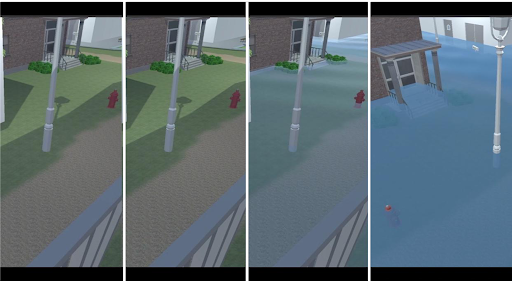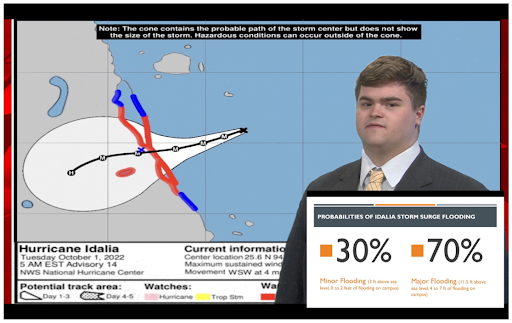A virtual workshop gives researchers insight about people’s responses to hurricane warnings
The Background
Hurricanes are destructive storms that can threaten large portions of the East Coast and Gulf states. They bring strong winds and heavy rain. The main threat, however, is storm surge, which is when storm winds push ocean water up onto land causing flooding and is the leading cause of death from these storms. While a lot of research and technological advancements have focused on improving the forecasting of hurricanes, not as much innovation has been put into developing more effective communication tools for these storms.
Better forecasts help to save lives by allowing vital time for people to protect property and evacuate if necessary. But these forecasts are useless unless people actually receive and heed warnings and take action. Not everyone can act on these warnings, and some people choose not to. Ignoring these warnings places all kinds of people in danger, residents and rescue teams alike.
The Goal
We wanted to figure out other ways to get people to heed these warning systems. Researchers from Stony Brook University, George Mason University, Howard University, and the EPA collaborated to design a workshop to investigate communication tools that might be more effective. This workshop included multiple elements:
- animated “hyper-local” immersive visualizations of storm surge, such as road signs and cars being submerged
- role-playing
- narrative
- a tool called the ethical matrix, which facilitates discussions among decision-makers about values, conflicts, and differences.
The Experiment
The Stony Brook Center for Visual Computing created a fake 3-dimensional coastal college campus that could be flooded to show the extent of potential minor (3 feet) and major (11.5 feet) storm surge. We recruited student participants from colleges across the country to attend the 4-hour online workshop. Participants were also assigned a character to play with a backstory that would affect their likelihood or ability to heed the warnings and evacuate.

Storm surge flooding simulation at 0 ft (0m), 3 ft (1m), 9 ft (3m), 11.5 ft (3.5m).
The participants also experienced a narrative about the characters interacting on the fictional campus while a distant hurricane gradually escalated in forecast severity, eventually impacting the campus as a major storm. Interspersed throughout the narrative was the college’s “student meteorologist” giving updates about the weather. Half of the participants also received the immersive, animated videos of major and minor storm surge flooding on the campus as part of their weather update.

Graphics the participants were shown as part of the weather update with percentage of minor and major flooding two days before landfall.
The narrative ended ambiguously, where participants could choose to evacuate or not and wonder about the storm’s effects. After the storm, campus administration asked the characters to discuss how prepared the school had been for the storm. In character, the participants used an ethical matrix to talk about how well the administration took care of the characters and their unique challenges when it came to evacuating for the storm.
The participants met with other participants role-playing as the same character to discuss their character’s backstory and fill out the first part of the ethical matrix, the values matrix. In the values matrix, decision-makers list their values, such as what they need to be happy and healthy, have autonomy, and what type of world they want to live in.
Next, the participants were sorted into groups with at least one of each character. Facilitators then guided these groups to fill out the consequence matrix, where participants discussed the decisions and steps that could have been taken to prepare for the storm. The groups also discussed how to minimize any harm and maximize the benefits the decisions could have.
The Results
To measure changes in risk perception and taking protective actions, we surveyed the participants throughout the workshop. The results of the survey data are promising.
The workshop significantly increased:
(1) participants’ worry about themselves and their community
(2) intentions to take protective actions like putting out sandbags or buying flood insurance
(3) intentions to ask for and offer help to others to take protective actions
(4) awareness of the challenges others face in deciding on a course of action
Interestingly, the immersive storm surge visualizations did not affect the workshop participants, as the group that received the simulations and the group that did not had no differences in terms of when they chose to evacuate. In addition, the two groups displayed no differences on other measures. For instance, the group that received immersive, hyper-local visualizations of scenes like cars flooding, and the group that did not both responded similarly about the factors that encouraged them to decide to evacuate. This may indicate that other workshop components, possibly the narrative and ethical matrix aspects of the workshop, may have influenced participants’ evacuation decisions more than the immersive visualizations.
Looking Forward
In many parts of New York, flooding is a continual threat. The results of this workshop show the need for community interactions, discussions, and relationship building to promote taking protective actions. The research group is preparing another workshop involving the ethical matrix again, along with using the Reality Deck at Stony Brook University, an immersive visualization room. In this upcoming workshop, we plan to invite community leaders in areas with vulnerable populations to discuss challenges and support them in developing action plans. We are also interested in learning whether patterns evident in the online workshop will persist in a community workshop.
To continue building off of this work, we would like to share our work and results with communities that can benefit from these communication techniques, especially the ethical matrix framework. We hope that communities can utilize the ethical matrix to make decisions that can help all members of the community when disasters strike.
For further details about the online workshop, refer to the published Bulletin of the American Meteorological Society article. This research is supported by NSF under Grant 1940302.
